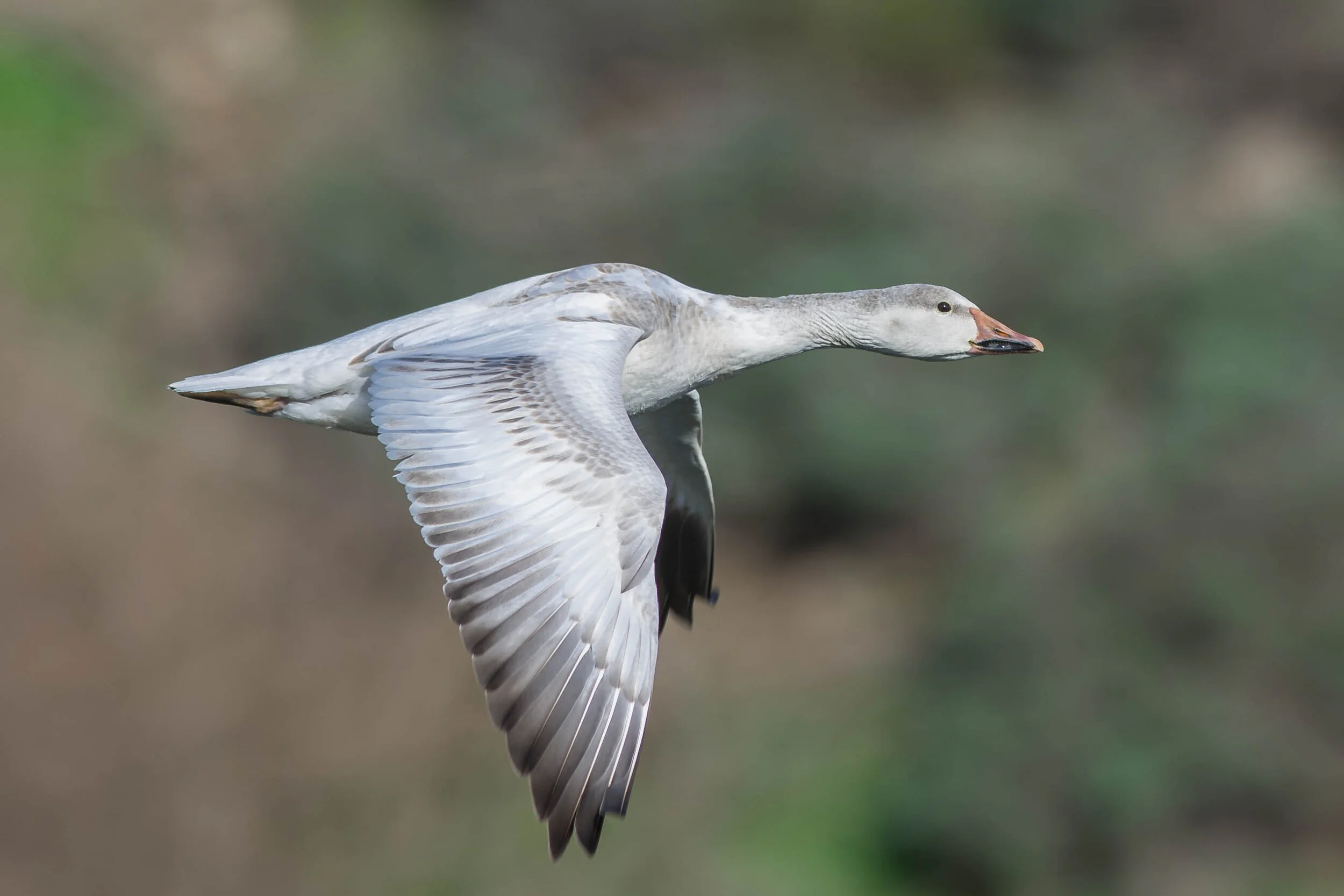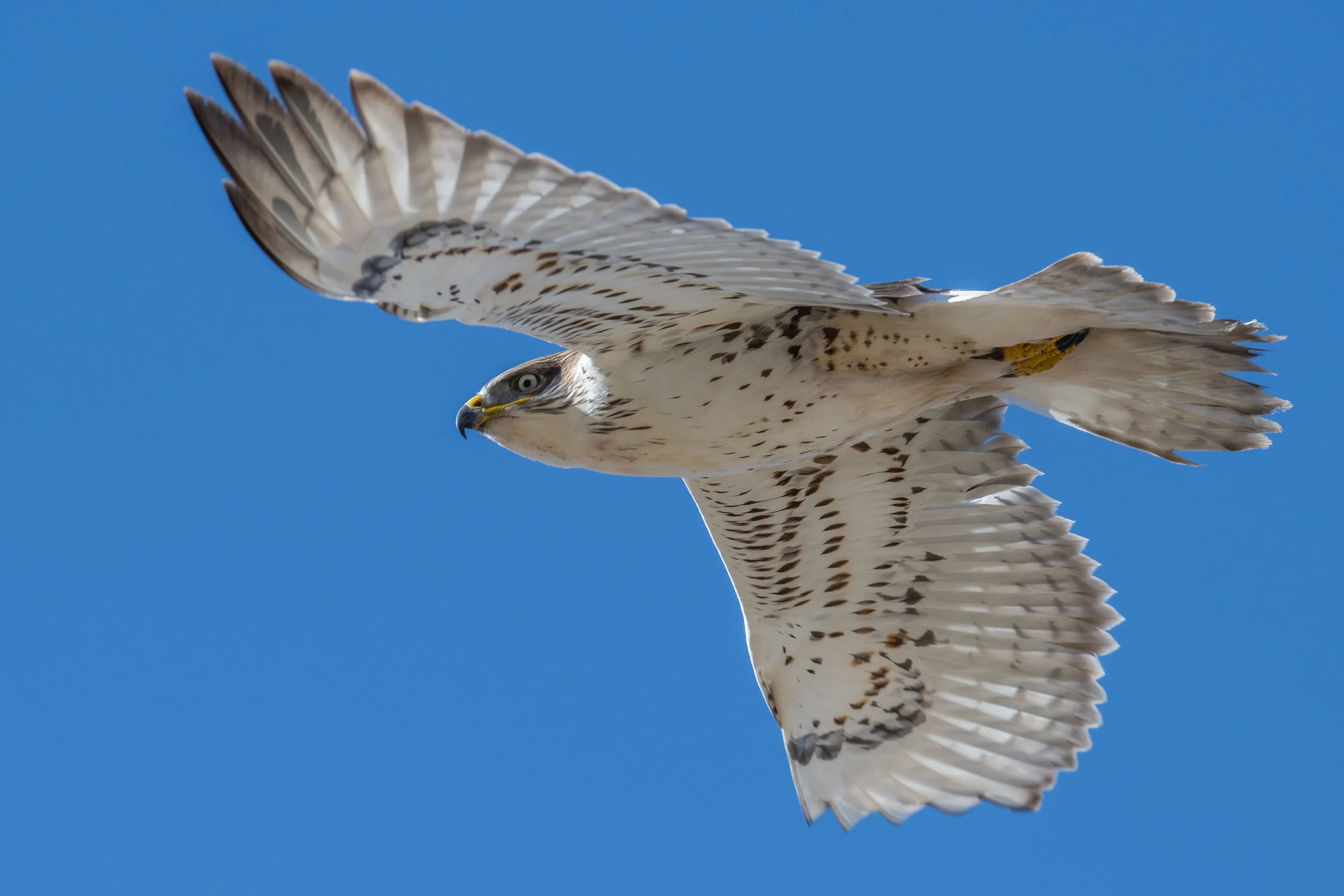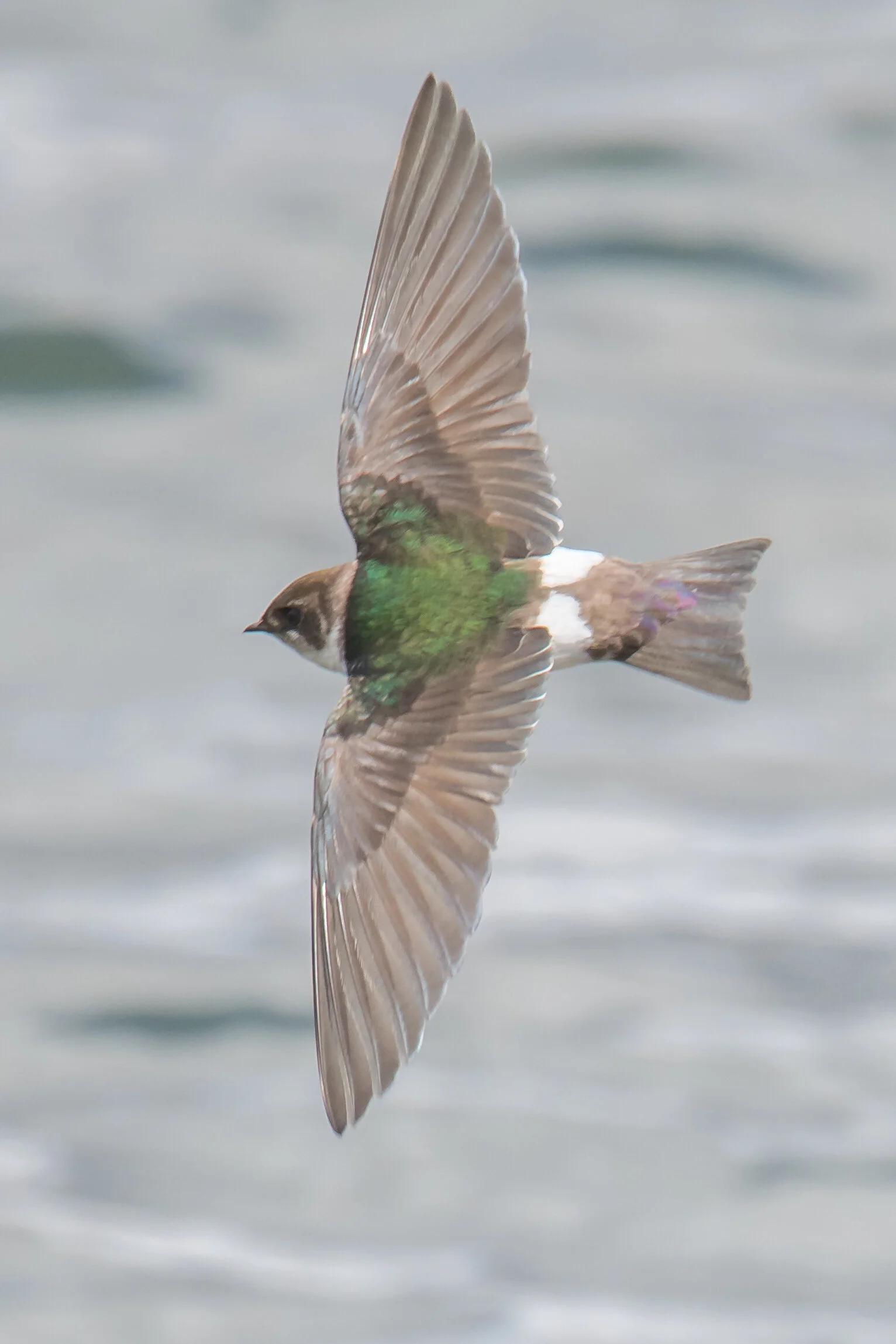Photographing birds is a challenge and when you add movement it make capturing a bird in flight more complex. To be successful you really need to know your camera so when an opportunity appears you can take advantage of it. I was walking along the Santa Cruz, CA coastline at Baldwin Creek. In this section, there are 100 to 150 ft cliffs and inland there is a lake about 100 ft below the bluffs. This Snow Goose was flying south toward me and I was able to capture the guy at eye level. Larger birds move more predictably so they are easier to photograph while in motion. I was able to capture this bird using 1/800s but I usually shoot at 1/1250s to 1/1600s.
Snow Goose (Chen caerulescens) - Baldwin Creek, SCZ (CA)
EQ: Nikon D7200, Nikkor 300mm f/2.8, 1.5x crop factor Taken: 01-12-2016 at 11:59
Settings: 500mm (35mm eqv), 1/800s, f/4.0, ISO100, +1/3EV, Conditions: sunny
The techniques I use has developed over time but one of the first was setting up my cameras with a continuous Back Button Focus. Cameras, by default, come with focusing by pressing the shutter release half way then pressing fully to capture the image. Using Back Button Focus allows for continuous focusing on the subject while taking multiple images, which is not possible with the focus tied to the shutter release button. I couldn’t have captured this Sabine's Gull picking a fish out of the lake without Back Button Focus.
Sabine's Gull (Xema sabini) - Little Washoe Lake, WAS (NV)
EQ: Nikon D850, Nikkor 500mm f/4 Taken: 9-27-2020 at 10:52
Settings: 500mm (35mm eqv), 1/1250s, f/5.6, ISO250, +1/3EV, Conditions: sunny
Sabine's Gull (Xema sabini) - Little Washoe Lake, WAS (NV)
EQ: Nikon D850, Nikkor 500mm f/4 Taken: 9-27-2020 at 10:52
Settings: 500mm (35mm eqv), 1/1250s, f/5.6, ISO450, +1/3EV, Conditions: sunny
Another helpful setting is to use a single point focus and exposure. My D850 has 155 focus points with 55 being selectable in camera. I usually have the center point selected but I move the focus point as the composition requires. I have reduced the number of selectable points from 55 to 15 so I can quickly change the focus point: Did I mention that birds often move? This Red-shouldered Hawk flew right over me and I took 20 or so images while constantly focusing on the eyes. The same was with the Sandhill Crane, Rough-legged Hawk, Ferruginous Hawk, and Swainson's Hawk where I put the center point on the eye of the bird (OK I like raptors).
Red-shouldered Hawk (Buteo lineatus) - Boynton Slough, WAS (NV)
EQ: Nikon D850, Nikkor 500mm f/4 Taken: 11-20-2020 at 10:28
Settings: 500mm (35mm eqv), 1/1250s, f/5.6, ISO250, +1/3EV, Conditions: sunny
Sandhill Crane (Antigone canadensis) - River Fork Ranch, DOU (NV)
EQ: Nikon D850, Nikkor 500mm f/4 Taken: 4-26-2019 at 8:28
Settings: 500mm (35mm eqv), 1/1600s, f/5.6, ISO250, +1/3EV, Conditions: sunny
Rough-legged Hawk (Buteo lagopus) - Swan Lake, WAS (NV)
EQ: Nikon D850, Nikkor 500mm f/4 Taken: 1-13-2020 at 9:40
Settings: 500mm (35mm eqv), 1/2000s, f/5.6, ISO720, +1/3EV, Conditions: sunny
Ferruginous Hawk (Buteo regalis) - Washoe Valley, WAS (NV)
EQ: Nikon D500, Nikkor 500mm f/4, 1.5x crop factor Taken: 1-2-2019 at 13:59
Settings: 750mm (35mm eqv), 1/1600s, f/5.6, ISO320, +1/3EV, Conditions: sunny
Swainson's Hawk (Buteo swainsoni) - Stillwater NWR, CHU (NV)
EQ: Nikon D7200, Nikkor 300mm f/2.8, 1.5x crop factor Taken: 6-22-2016 at 7:59
Settings: 450mm (35mm eqv), 1/2000s, f/5.6, ISO320, +1/3EV, Conditions: sunny
Now we are getting into the next level of capturing birds in flight. These Anna’s Hummingbirds were taken at 2 different shutter speeds with the the first taken at 1/3200s and the second at 1/2000s. The Anna’s wings beats are between 40 and 50 per second. There is more blur in the wings in the 1/2000s image but that adds to the feeling of motion; at least for me.
Anna's Hummingbird (Calypte anna) - Stapp Rd., SCZ (CA)
EQ: Nikon D800, Nikkor 300mm f/2.8 Taken: 1-31-2015 at 13:27
Settings: 300mm (35mm eqv), 1/3200s, f/2.8, ISO250, +1/3EV, Conditions: sunny
Anna's Hummingbird (Calypte anna) - Natural Bridges SP., SCZ (CA)
EQ: Nikon D800, Nikkor 300mm f/2.8 with 2.0x TC Taken: 3-22-2013 at 12:35
Settings: 600mm (35mm eqv), 1/2000s, f/8.0, ISO720, -1/3EV, Conditions: sunny
Another good reason to use Back Button and Center Point Focus is this photo I took of a Steller’s Sea Eagle along the east coast of Russia. I was able to keep the focus point on the eye with the Center Point Focus so the focus was constantly updated as the Eagle moved toward me. This is the same with the Harrier and Red-tailed Hawk interaction and the Bald Eagle that actually turned toward me instead of away.
Steller's Sea-Eagle (Haliaeetus pelagicus) - Zhupanova River, KAM (Russia)
EQ: Nikon D7200, Nikkor 500mm f/4.0, 1.5x crop factor Taken: 06-28-2017 at 9:44
Settings: 750mm (35mm eqv), 1/1200s, f/4.5, ISO800, +1/3EV, Conditions: foggy
Northern Harrier (Circus hudsonius) and Red-tailed Hawk (Buteo jamaicensis) - Diamond Creek Pond, WAS (NV)
EQ: Nikon D800, Nikkor 500mm f/4 Taken: 5-1-2018 at 14:28
Settings: 500mm (35mm eqv), 1/1250s, f/6.3, ISO100, +1/3EV, Conditions: sunny
Bald Eagle (Haliaeetus leucocephalus) - Little Washoe Lake, WAS (NV)
EQ: Nikon D7200, Nikkor 500mm f/4.0, 1.5x crop factor Taken: 10-13-2016 at 11:32
Settings: 750mm (35mm eqv), 1/1600s, f/5.0, ISO100, +1/3EV, Conditions: sunny
Another step up in difficulty is photographing Swallows, which are some what easier than Warblers with a caveat. The best photos of flying Swallows I was able to take was when the wind was higher than normal. This requires you to know where the Swallows are and head there when the wind picks up or get lucky, which is the case in these photos. The wind was about 15 mph and the Swallows were feeding along this pond. It was almost impossible to photograph them when they flew with the wind but the opportunity was when they flew into the wind. Another helpful tool, if your camera has the option, is to set up a 4 point focus cluster on one of your camera’s programmable buttons. I find that this helps in obtaining focus with busy backgrounds but I haven’t been very successful in obtain sharp eye focus compared to the single point focus.
Violet-green Swallow (Tachycineta thalassina) - Diamond Creek Pond, WAS (NV)
EQ: Nikon D850, Nikkor 500mm f/4 Taken: 4-27-2021 at 12:15
Settings: 700mm (35mm eqv), 1/1600s, f/5.6, ISO500, +1/3EV, Conditions: overcast
Violet-green Swallow (Tachycineta thalassina) - Diamond Creek Pond, WAS (NV)
EQ: Nikon D850, Nikkor 500mm f/4 Taken: 4-27-2021 at 12:12
Settings: 700mm (35mm eqv), 1/1600s, f/5.6, ISO500, +1/3EV, Conditions: overcast
Bank Swallow (Riparia riparia) - Diamond Creek Pond, WAS (NV)
EQ: Nikon D850, Nikkor 500mm f/4 Taken: 4-27-2021 at 12:14
Settings: 700mm (35mm eqv), 1/1600s, f/5.6, ISO500, +1/3EV, Conditions: overcast
Cliff Swallow (Petrochelidon pyrrhonota) - Diamond Creek Pond, WAS (NV)
EQ: Nikon D850, Nikkor 500mm f/4 Taken: 4-27-2021 at 12:11
Settings: 700mm (35mm eqv), 1/1600s, f/5.6, ISO500, +1/3EV, Conditions: overcast
Here and a few more of my favorite inflight bird photos.
Black-footed Albatross (Phoebastria nigripes) - Monterey Bay Pelagic, MTY-SCZ (CA)
EQ: Nikon D7200, Nikkor 300mm f/2.8, 1.5x crop factor Taken: 9-5-2015 at 11:33
Settings: 450mm (35mm eqv), 1/1600s, f/5.6, ISO450, +1/3EV, Conditions: sunny
Sharp-shinned Hawk v Steller's Jay - Stapp Rd., SCZ (CA)
EQ: Nikon D7200, Nikkor 300mm f/2.8, 1.5x crop factor Taken: 4-3-2016 at 8:46
Settings: 450mm (35mm eqv), 1/2500s, f/4.5, ISO320, +1/3EV, Conditions: sunny
Caspian Tern (Hydroprogne caspia) - Pyramid Lake, WAS (NV)
EQ: Nikon D7200, Nikkor 300mm f/2.8, 1.5x crop factor Taken: 8-17-2016 at 9:08
Settings: 450mm (35mm eqv), 1/1600s, f/5.6, ISO280, +1/3EV, Conditions: sunny
Your comments are welcomed and if you have any questions about these photos or any other leave me a message.




















